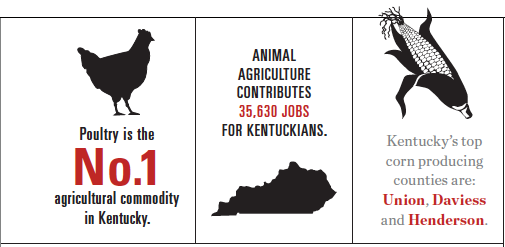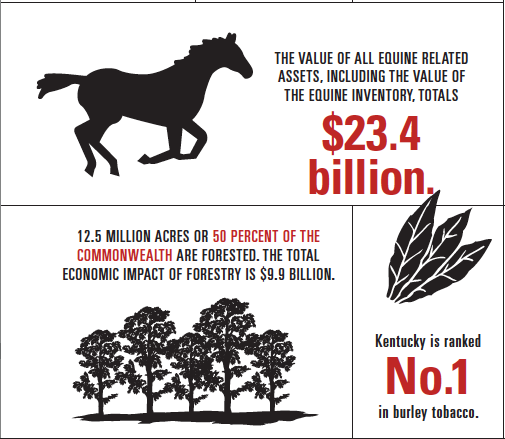Home > Kentucky > Kentucky Crops & Livestock > Kentucky Agriculture Overview
Kentucky Agriculture Overview
The Bluegrass State is a cornucopia of agricultural commodities. Kentucky boasts 13.9 million acres of lush farmland covering 54 percent of the state. Kentucky is in the top five nationally for the highest number of farms with 85,300. The average farm size in the state is 164 acres.
Various types of rich soil make up the gently rolling hills and scenic pastures. The Crider soil series, the most prevalent varieties, cover 500,000 acres and 35 counties in the state. The Crider soils are deep, well-drained and extremely productive, ideal for growing Kentucky’s top commodities such as wheat, soybeans, corn and hay.
The Crider soils are also perfect for growing Kentucky’s No. 6 commodity, tobacco. Ranked No. 1 nationally for burley tobacco, Kentucky produces 262.5 million pounds annually. Conveniently, Lexington is home to the world’s largest burley tobacco market. In addition to burley tobacco, Kentucky also leads the country for dark fired tobacco and dark air tobacco.
Kentucky has a robust animal agriculture industry ranging from horses to aquaculture and cattle to sheep. Half of Kentucky’s farm income is generated by livestock and livestock products.
Kentucky ranks No. 5 in goat farming and is home to approximately 68,000 goats.
Forest and timber are another major source of income for Kentucky. Commercial forest covers 12.5 million acres, or 50 percent of the state. Kentucky ranks No. 3 in the nation for hardwood production. White oak, red oak, walnut, yellow poplar, beech, sugar maple, white ash and hickory are the most prevalent species of trees.
The agriculture industry in Kentucky generates $17 billion per year and employs more than 400,000 people. Farmers contribute to the state economy by paying more than $200 million in wages a year and more than $50 million in property taxes.
Agriculture provides food, fiber and fuel to both Kentucky and the nation. And with some of the country’s top exports, Kentucky holds its own in the global economy.






[…] is in the top five nationally for the highest number of farms. Why should urban and suburban community members be excluded from […]
[…] is in the top five nationally for the highest number of farms. Why should urban and suburban community members be excluded from […]